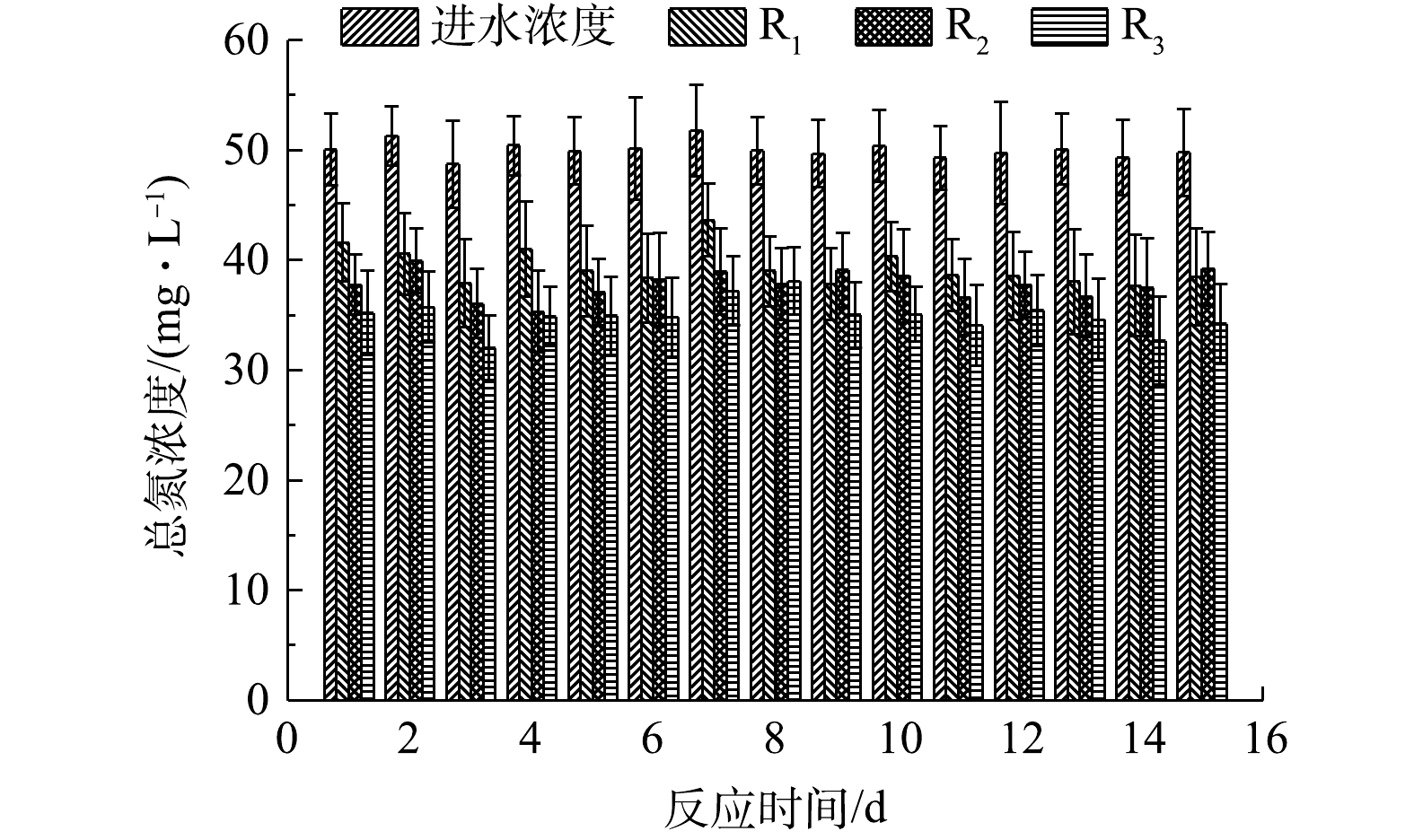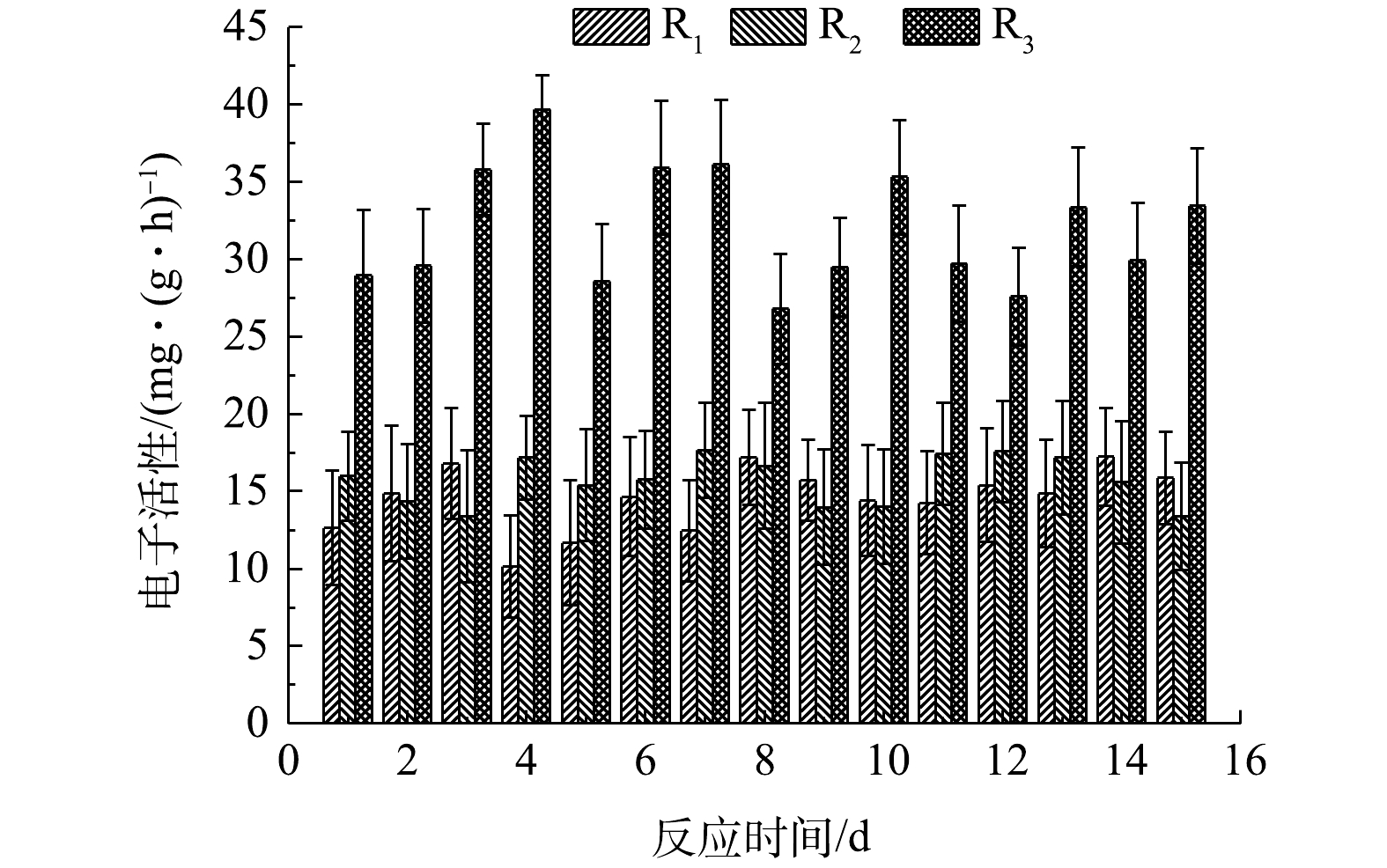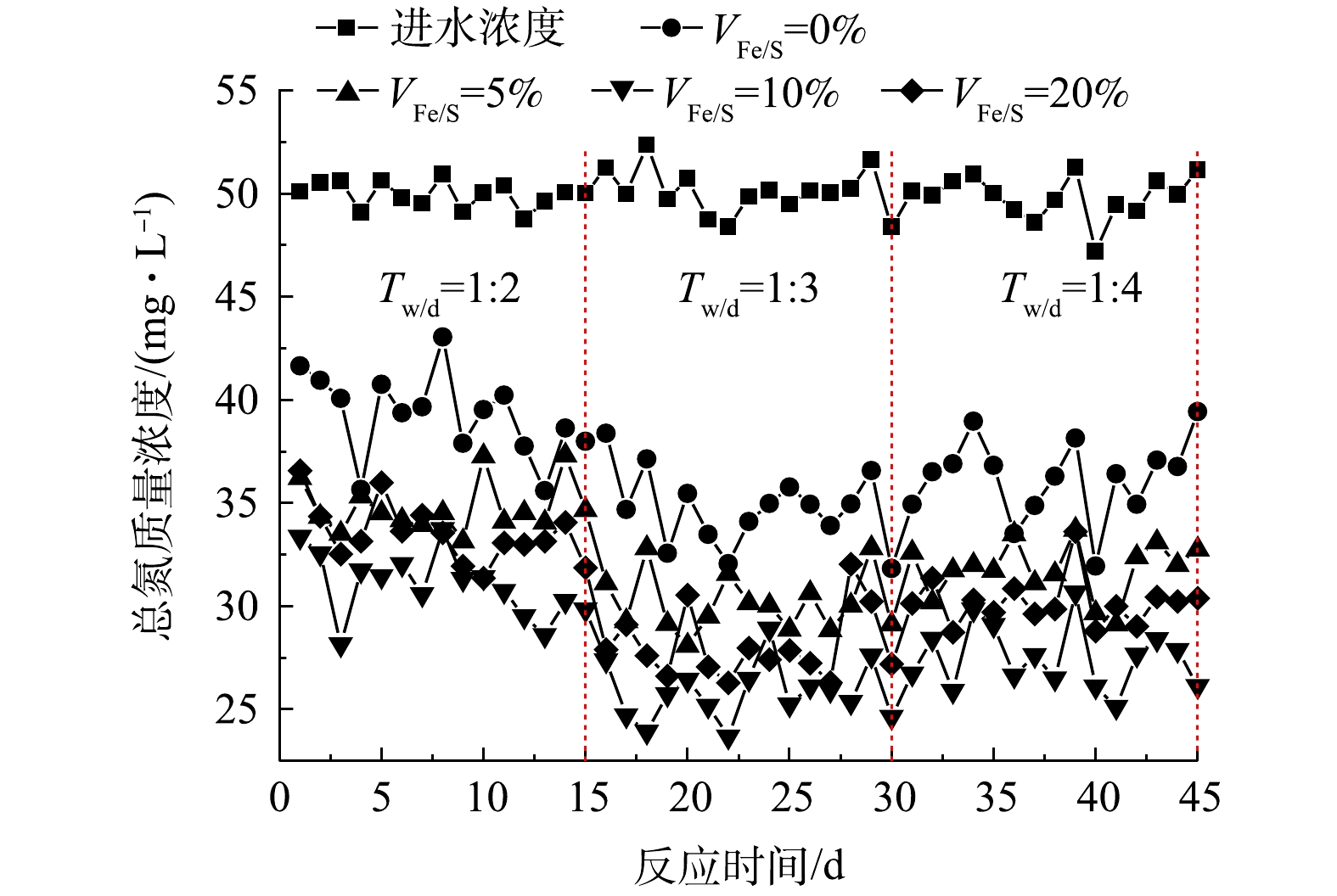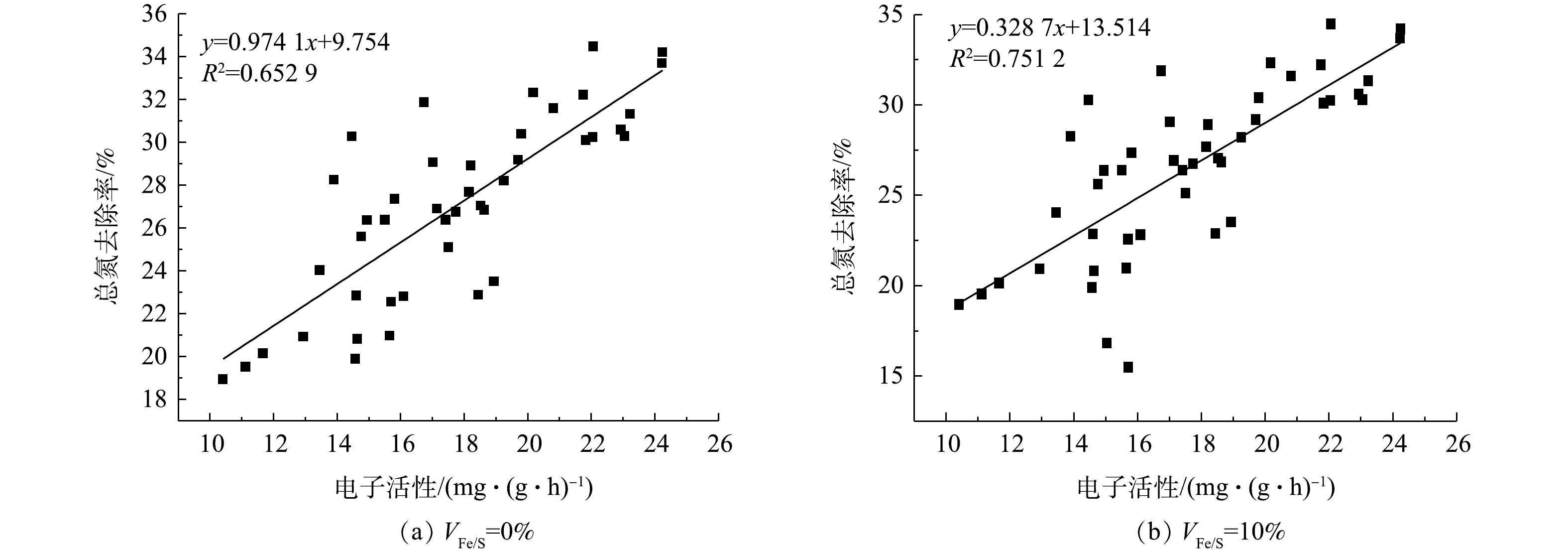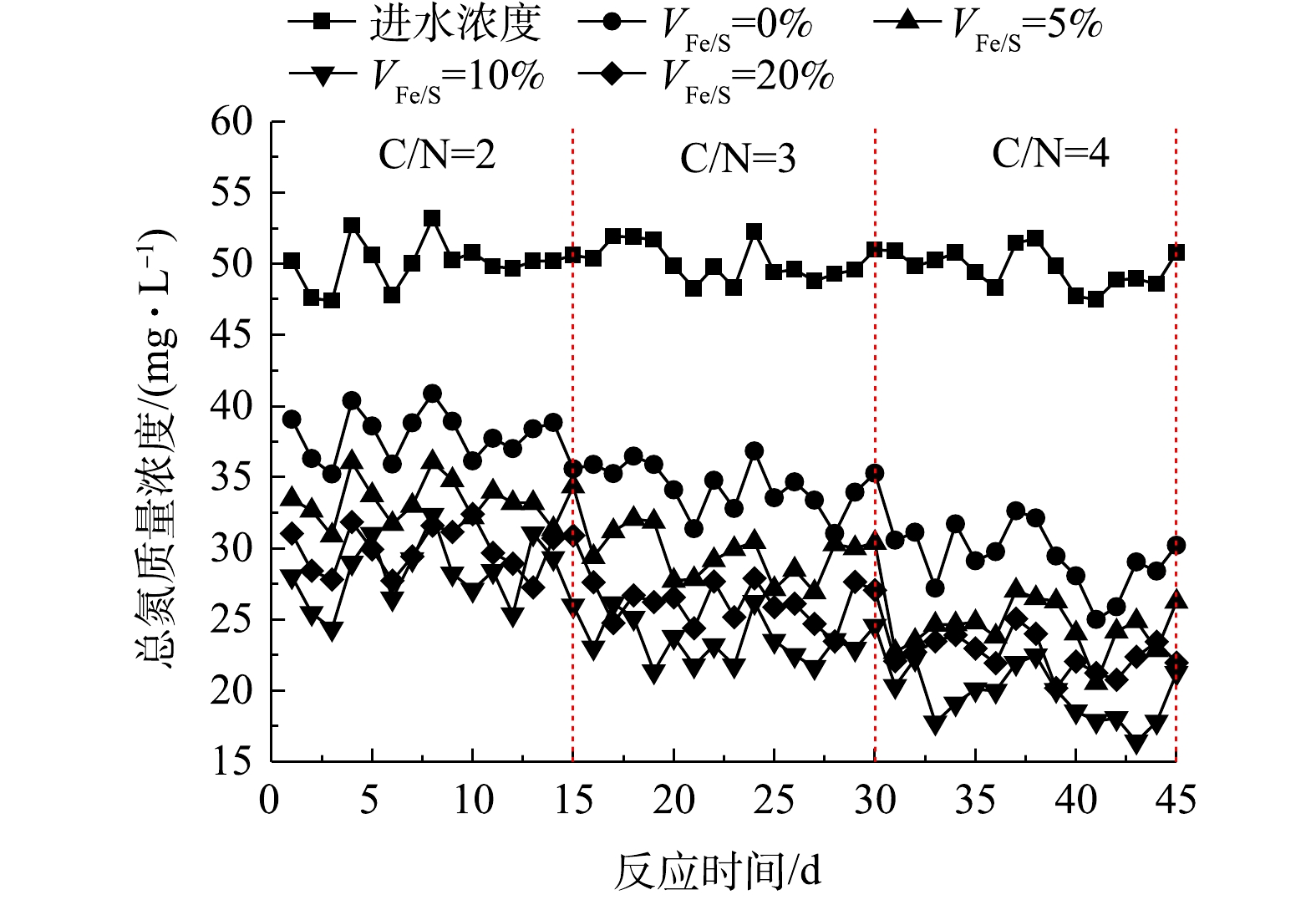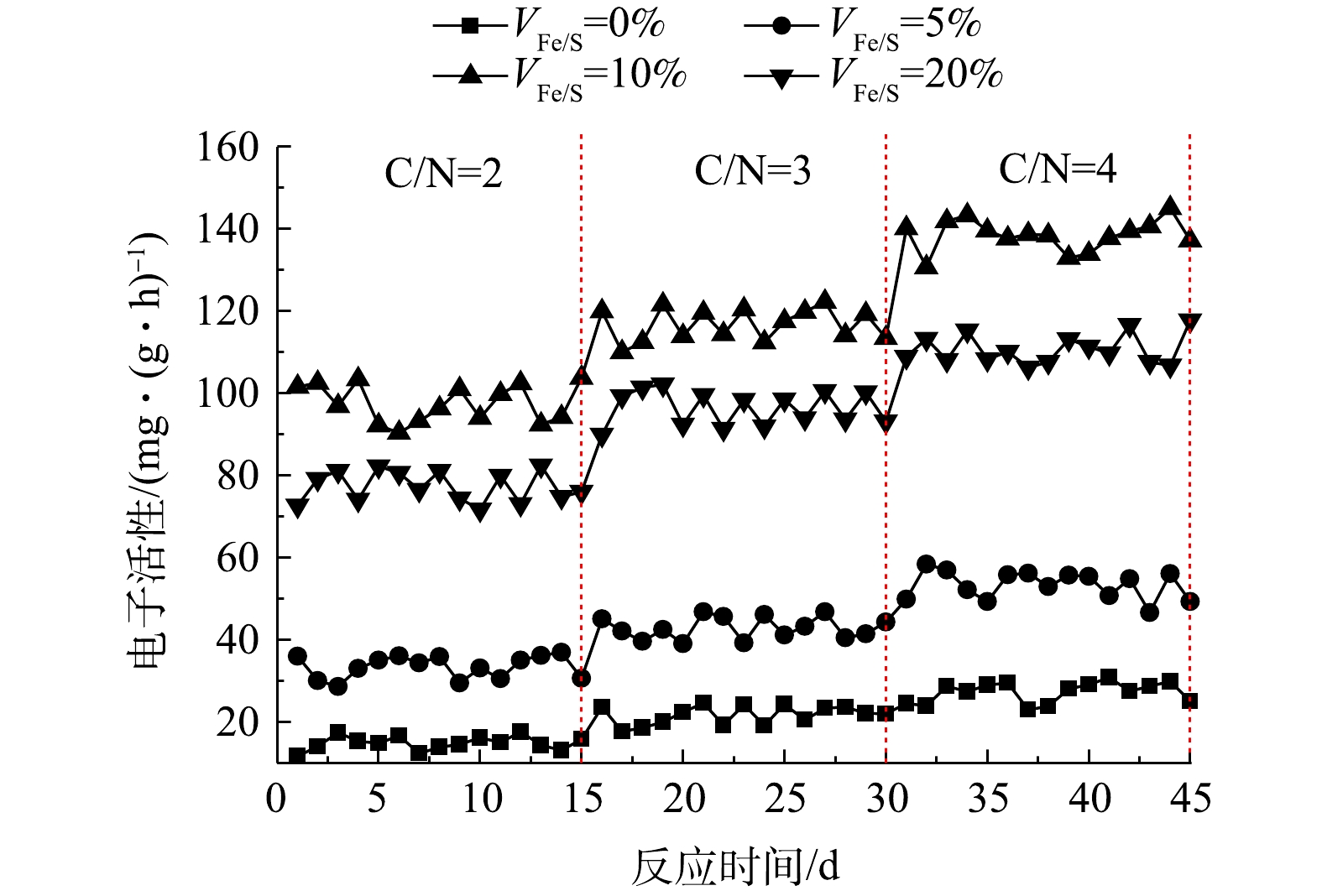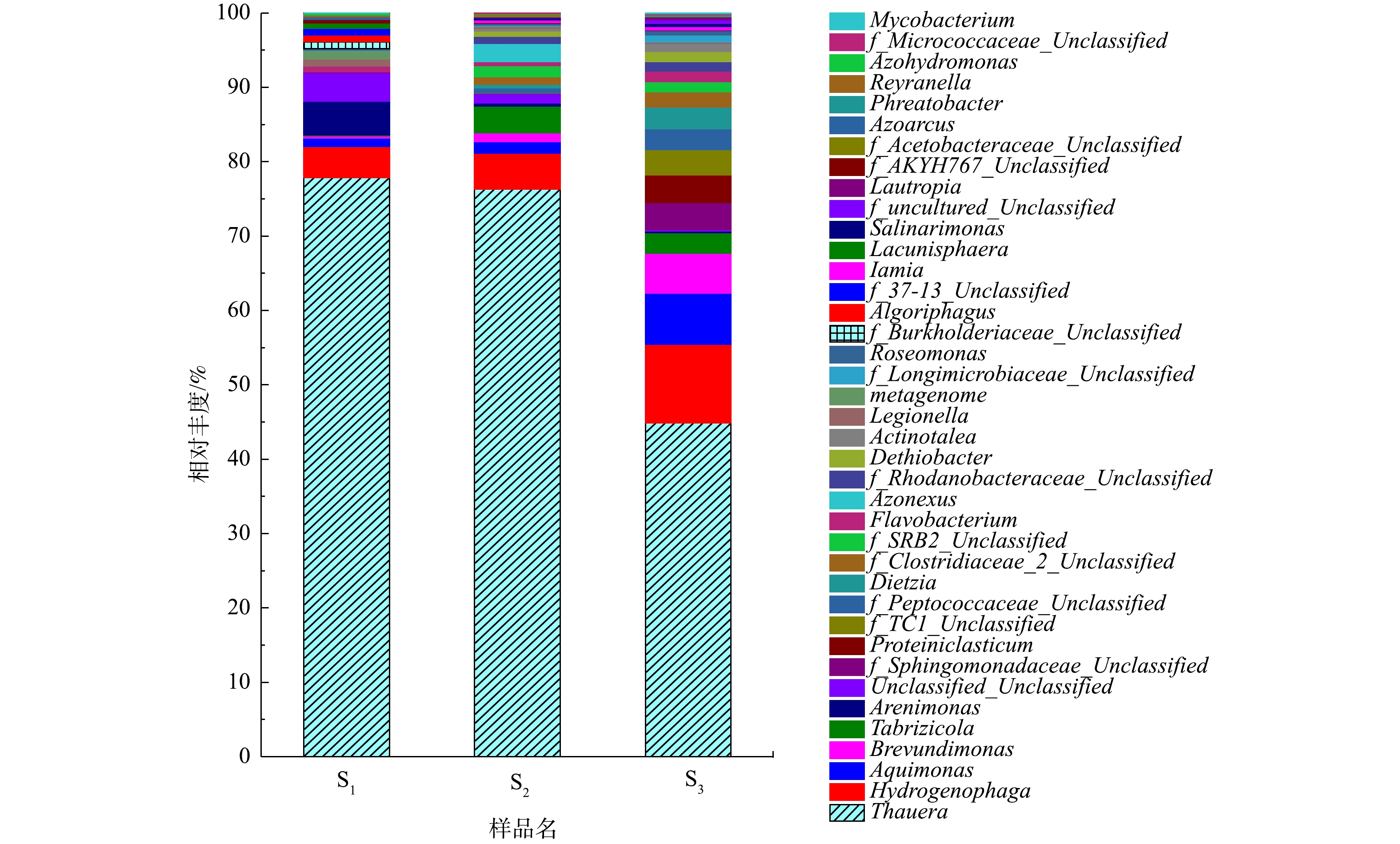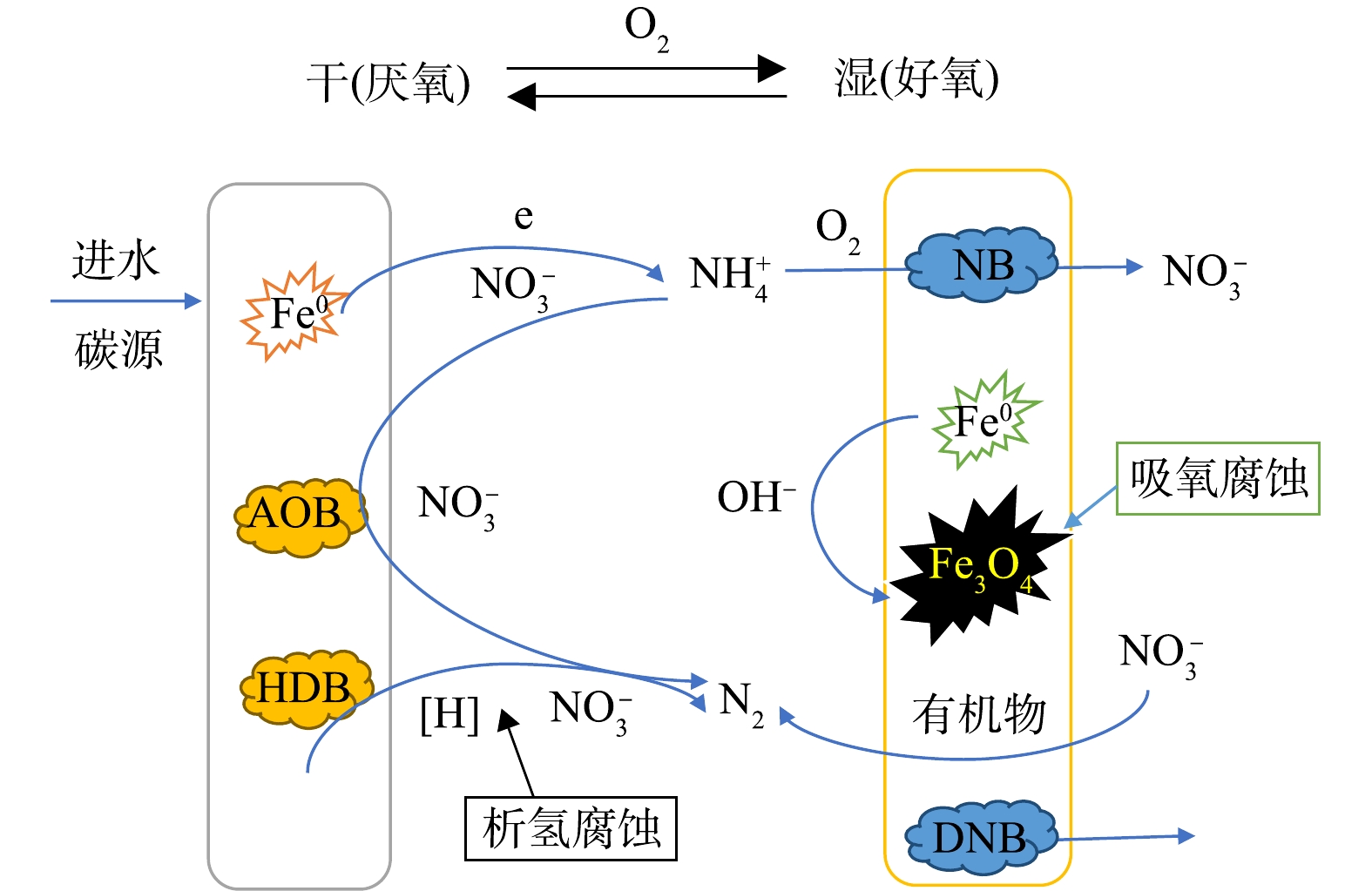-
当前我国农村生活污水因其废水C/N比偏低,致使反硝化所需碳源不足,无法提供充足电子,抑制了生物脱氮过程[1]。近年来,研究者探索采用微气泡曝气生物膜反应器[2],AOA-SBR[3]、CW-BER[4]、微生物燃料电池[5-6]和超滤膜与硝化/反硝化[7]等方法,以改善低C/N比污水脱氮效率低的现状;尤其在利用废弃生物质作为固体缓释碳源方面做了大量的研究[8-11],在一定程度上达到了强化脱氮的目的;但该方法存在因释放不稳定导致出水有机物过高的问题。因此,探寻节能高效、简单易行的脱氮新技术具有十分重要的意义。
人工快渗(constructed rapid infiltration,CRI)滤料渗透性能良好、干湿交替运行、兼具过滤和生物降解的双重功能,因而具有基建投资少、工艺简单、管理方便和能耗低等优点,在处理农村生活污水和受污染地表水方面备受关注[12-15]。近年来,陈佼等[16]运用亚硝化-厌氧氨氧化工艺,为解决CRI系统TN去除率低的问题提供了新方法;SU等[17]设计了以砾石、沙子、焦炭和沸石为混合填料的新型CRI,实现了90%的TP的去除率,其在改变CRI运行方式、补充有机碳源和多技术耦合等研究方面亦取得了一定的进展。
铁型反硝化技术是以零价铁(ZVI)或Fe2+替代有机物作为反硝化电子供体的新型脱氮技术,是处理低C/N比污水有效途径之一[18]。纳米零价铁(nZVI)因其粒径小、比表面积大和反应活性高等优点在强化微生物脱氮方面得到了较好的应用[19-22],但其在实际应用存在抗氧化性弱、易团聚和易堵塞系统等缺点[23]。ZHAO等[20-21]以SA/Mt-nZVI作为额外的电子供体处理污水时,发现增加了10%~20%的TN去除率;将花生壳固体碳源与nZVI联用使用显著改善了自养和异养反硝化作用,从而强化生物脱氮效率。
基于CRI的优势和nZVI处理低C/N比污水的不足,本研究向CRI系统填料中混入微米粒径的零价铁粉(记作ZVIP),构建了ZVIP-CRI协同体系。在改善CRI渗透性能的同时,通过营造干湿交替(好氧/缺氧)的运行环境,强化ZVIP缓慢氧化腐蚀释放电子,探索ZVIP强化CRI处理低C/N比污水脱氮的可行性。考察了铁砂体积比(VFe/S)、湿干时间比(TW/D)和碳氮比(C/N)对ZVIP-CRI协同体系INT-ETS和TN去除率的影响,并通过高通量测序分析了填料脱氮功能菌群变化,探索了可能的脱氮机制,以期为ZVIP强化CRI反硝化脱氮性能研究提供参考。
全文HTML
-
采用聚氯乙烯材料搭建模拟CRI中试系统。单个反应柱内径为20 cm,柱高180 cm,填料层高度为130 cm。反应柱顶部设置布水管均匀布水,在侧面设置出水采样口。ZVIP为工业级零价铁粉,含Fe量≥ 98.55%,铁粉颗粒呈现小球状,粒径为0.5~5 μm。河砂采用天然河砂,粒径为0.25~0.5 mm。
-
采用自然接种方式挂膜启动,依照C∶N∶P=100∶5∶1,分别向水中添加适量的C6H12O6、NH4Cl和KH2PO4等营养物质,并混入10%体积比的城市污水厂厌氧消化池污水,配置的模拟污水COD约为(300 mg·L−1),通过逐步提高系统水力负荷启动CRI。在水力负荷周期24 h,TW/D 为1∶2的条件下连续稳定运行,当运行至第16天时,水力负荷达到1.0 m·d−1,COD去除率达到60%以上。镜检发现生物相良好,系统微生物已逐渐稳定,再持续稳定运行5个周期后确认挂膜成功。后续采用人工配水,分别以CH3COONa和NaNO3为唯一碳源和氮源,配置实验所用的模拟含氮污水。以上实验均在室温((25±3) ℃)条件下进行。
-
以一定比例的ZVIP和河砂作为CRI柱的填料,均匀混合后填入CRI柱中。未投加ZVIP记为传统CRI,投加ZVIP的记为ZVIP-CRI协同体系。脱氮可行性实验搭建了3组实验柱,影响因素实验分别考察了湿干比(TW/D)、C/N比和铁砂体积比(VFe/S)对INT-ETS值和TN去除率的影响。具体实验方案如表1和表2所示。
-
COD采用快速消解分光光度法(HJ/T 399-2007)。
${\rm{NO}}_3^{-} $ -N采用紫外分光光度法 (GB HJ/T 346-2007)。TN采用过硫酸钾氧化/紫外分光光度法(GB/T 11894-1989)。根据对电子活性的相关研究[24-26],利用电子传递体系(Electron Transport System,ETS)方法检测系统ETS活性,通过对比系统ETS值,分析其与脱氮性能的相关性。INT-ETS具体测定方法如下:以碘硝基四氮唑(INT)作为脱氢酶活性测定剂,通过测定还原产物的吸光度来定量负载微生物在呼吸链上的电子传递速率[27-28],即向10 mL的离心管中依次加入0.3 mL混合液、1.5 mL的Tris-HCl缓冲液和1.0 mL的0.2% INT溶液,将制备完的样品放在37 ℃的振荡器内,暗处振荡培养30 min,再加入浓度为37%的1.0 mL的甲醛溶液以终止酶反应。将样品在4 000 r·min−1 下离心5 min,弃去上清液,加入5.0 mL的甲醇,混合搅拌均匀,在37 ℃下暗处振荡萃取10 min。在4 000 r·min−1下再离心5 min,并在紫外分光光度计485 nm处读取萃取液的吸光度,经过离心沉淀后在105 ℃条件下烘干1 h后称量生物量干质量。利用碘硝基四氮唑(INT)检测电子传递体系活性(INT-ETS)的计算如式(1)所示。式中:R为INT-ETS值,mg·(g·h)−1;D485为波长485 nm处上清液吸光度;V为萃取剂体积,mL;ki为标准曲线斜率,W为生物量干质量,mg;t为培养时间,h。
高通量测序:取一定量样品,在样品管中加入适量的PBS溶液强烈振荡,使样品表面菌体能够被洗出,取适量洗过的液体离心沉淀,具体提取步骤参照商业DNA提取试剂盒(Magen Hipure Soil DNA kit,中国)完成。从每个样品中提取250 mg的DNA,测定其吸光度,并通过1%琼脂糖凝胶电泳检查DNA质量与完整性。使用Qubit 2.0荧光仪(Invitrogen公司,美国)对基因组DNA的浓度进行定量,以确定PCR反应加入的DNA量。PCR所用的引物已经融合了Illumina MiSeq平台(Illumina, San Diego, USA)测序平台的V3~V4 通用引物,使用以下引物对聚合酶链反应(PCR)扩增V3和V4区域:正向5′-CCT ACG GRR BGC ASC AGK VRV GAAT-3′和反向5′-GGA CTA CNY VGG GTW TCTAAT CC-3′。利用检测试剂盒对回收的DNA精确定量,以方便将样品与100%乙醇按1∶1(v∶v)的比例等量混合后测序。
1.1. 装置及材料
1.2. 挂膜启动
1.3. 实验方案设计
1.4. 分析方法
-
对ZVIP作为电子供体强化CRI脱氮的可行性进行了实验探索,结果如图1~图3所示。由图1~图3可以看出,R1、R2、R3中
$ {\rm{N}}{{\rm{O}}^ - _3}$ -N和TN的平均去除率分别为28.68%和21.32%、30.20%和24.49%、35.22%和30.20%,其中INT-ETS的平均值分别为14.54、15.70和32.01 mg·(g·h)−1。对比$ {\rm{N}}{{\rm{O}}^ - _3}$ -N和TN的去除率发现,因电子供给不足,反硝化不彻底,导致R1、R2、R3的$ {\rm{N}}{{\rm{O}}^ -_3} $ -N和TN去除率有一定的差值(7.36%、5.70%和5.02%)。R1的TN去除率低于R2,且R3的TN去除率远高于R1和R2。由此可见,在不投加有机碳源下,ZVIP亦可有效增强对$ {\rm{N}}{{\rm{O}}^ -_3} $ -N的去除。INT-ETS值反映了脱氮过程中的电子传递活性。对比R2和R3的INT-ETS值和TN去除率可知,补充有机碳源可增强电子传递活性,加快反硝化过程,从而获得更好的脱氮性能。 -
1)湿干比对ZVIP/CRI协同体系脱氮的影响。不同湿干比对INT-ETS值和TN出水质量浓度的影响如图4~5所示。在水力负荷周期为12 h、进水C/N为4、协同体系的TW/D分别为1∶2、1∶3和1∶4时,TN平均出水质量浓度分别为(33.10±2.08)、(28.02±2.20)和(29.85±2.33) mg·L−1,TW/D为1∶3相较于1∶2和1∶4的体系中,TN平均去除率分别提高了10.36%和3.91%,INT-ETS平均值分别为(56.28±23.93)、(81.32±36.80)和(65.53±30.31) mg·(g·h)−1,TW/D 为1∶3时的INT-ETS平均值是1∶2和1∶4时的1.44倍和1.24倍。不同TW/D条件对传统CRI和VFe/S为10%的协同体系INT-ETS值与TN去除率的相关性结果如图6所示。由图6可知,其可决系数R2分别为0.652 9和0.751 2(均大于0.6)。可见,不同TW/D条件下的INT-ETS值均可作为衡量TN去除率的指标,且VFe/S为10%的协同体系相关性更高。
2) C/N比对ZVIP/CRI体系脱氮的影响。C/N比对出水TN浓度影响结果见图7和图8。在水力负荷周期为12 h、TW/D为1∶3、C/N为2、3和4时,传统CRI中TN的平均出水质量浓度为40.79、37.04和31.85 mg·L−1,平均去除率为18.53%~35.92%,系统平均INT-ETS值分别为14.80、21.65和27.22 mg·(g·h) −1。可见,C/N比变化会影响系统内电子传递活性,进而影响到出水TN质量浓度。协同体系在C/N=2、3和4运行时,TN出水质量浓度分别为(33.07±3.22)、(28.37±3.31)和(23.61±2.84) mg·L−1,对应TN平均去除率分别为(33.96±6.42)%、(43.42±6.61)%和(52.49±5.73)%。相应的平均INT-ETS值分别为(69.42±36.04)、(85.34±42.45)和(100.84±47.51) mg·(g·h) −1。对比发现,C/N=4时TN平均去除率比C/N=2和3的去除率分别提高了18.53%和9.07%。
3)铁砂体积比对ZVIP-CRI协同体系脱氮的影响。由图4~图5可知,不同VFe/S对ZVIP-CRI协同体系的TN去除率和电子活性有较大的影响。在水力负荷周期为12 h、TW/D为1:3、C/N为4,VFe/S分别为0%、5%、10%和20%时,系统TN的平均出水质量浓度分别为34.73、30.14、25.82和28.10 mg·L−1,TN平均去除率依次为30.68%、39.80%、48.42%和43.89%,系统中的平均INT-ETS值分别为21.22、44.52、109.04和90.40 mg·(g·h)−1。随着ZVIP投加量的增加,TN去除率和INT-ETS值均呈先上升后下降的趋势。可见,VFe/S会影响系统内电子传递活性,进而影响出水TN浓度,且协同体系中的INT-ETS值和TN去除率均高于传统CRI。对比不同VFe/S下的INT-ETS值可知,在VFe/S为10%时,系统平均INT-ETS最高,分别为VFe/S为0%、5%和20%时的5.14、2.45和1.21倍,其对应的TN去除率分别提高了17.74%、8.62%和4.53%。
-
在水力负荷周期为12 h、TW/D=1:3、C/N=4的条件下,分别从VFe/S为0%、5%、10%的3组CRI柱中取样,记作S1、S2、S3。采用高通量测序对微生物群落结构进行了分析,结果如图9所示。由图9可知,在淹没(厌氧)条件下,陶厄氏菌属(Thauera) 在反应器中占绝对优势[24];相对丰度较高的有Brevundimonas和Arenimonas和Tabrizicola菌属,其均与反硝化作用密切相关[29-30];同时,还含有一定丰度的厌氧氨氧化菌属(AAOB)Hydrogenophaga[31-32]。上述各类菌属共同构成了ZVIP-CRI反硝化系统中的优势菌属,为强化脱氮效率提供了稳定的微生物群落结构基础,这与Fe3O4纳米粒子在反硝化中的促进作用基本一致[33]。在样品S2和S3中,Thauera相对丰度由S1的77.88%降低至76.32%和44.88%,Tabrizicola相对丰度由0.11%提高至3.57%和2.73%,Brevundimonas相对丰度由0.28%提高到1.22%和5.36%,Arenimonas相对丰度由4.54%降低至0.39%和0.28%,Hydrogenophaga相对丰度由4.19%提高到4.84%和10.55%。这在某种程度上证实了在协同体系中的自养反硝化作用被强化,这主要是因为富铁环境有利于反硝化微生物的聚集,同时也说明系统中可能存在多种生物脱氮途径,从而有利于脱氮效率的提高。
-
上述结果表明,在相同进水和水力负荷周期条件下,ZVIP/CRI协同体系的脱氮效果明显高于传统CRI,且随着ZVIP投加量的增加,电子传递活性更高。这可归因于ZVIP腐蚀后具有疏松多孔结构(图10),对微生物具有较好的界面富集作用,不仅有利于电子转移及生物转化,而且可通过填料的吸附截留降低出水TN浓度;同时ZVIP腐蚀产生的 Fe2+和 H2可为微生物代谢提供电子供体和营养物质,提高微生物脱氢酶活性[34-35],电子参与了反硝化细菌(NB)的脱氮反应[36-37](式(2))。高通量测序结果亦表明,反硝化菌属丰度显著增加,这与叶星等[38]得出的反硝化生物滤池脱氮效果和脱氢酶活性之间的关系结论相一致。值得注意的是,相比S1和S2,S3出现了一定丰度的厌氧氨氧化菌属,这可能是
$ {\rm{N}}{{\rm{O}}_3}^ - $ -N被ZVIP直接还原后(式(3)),其主要产物$ {\rm{N}}{{\rm{H}}^ +_4} $ -N在CRI淹没(缺氧)环境中,在厌氧氨氧化细菌的作用下,达到强化脱氮的目的[39-40]。通过改变系统湿干时间比,使系统内淹没、落干时间发生变化。在传统CRI中,在淹水时间较长的条件下,自然复氧量降低,有机碳源氧化分解不足,对异养反硝化细菌提供的电子数量减少,从而影响CRI反硝化脱氮性能[10,14]。传统CRI与协同体系对TN平均去除率均是先升高后降低,系统内的INT-ETS值也与去除率呈正相关趋势,协同体系在运行30 d内仍具有较好的微生物活性,保持了较高的TN去除率。有研究[41]表明,铁在有氧环境下会在其表面形成一层致密的钝化氧化膜,其主要成分为针铁矿(FeOOH),该钝化氧化膜阻碍了Fe腐蚀释放电子,也抑制了电子转移;而在CRI淹没(缺氧)环境中会发生析氢腐蚀(式(4)),产生的大量H2会在水中形成电子及H+,而在酸性条件下,FeOOH可与H+迅速生成Fe3+,并转化为Fe3O4(式(5)),导致腐蚀层中Fe3O4组分相对含量急剧增大,强化了电子在系统填料中的流转传递[42];另外,腐蚀产物也加速了反硝化得电子的效率,在反硝化细菌(NB)和氢型反硝化细菌(HDB)作用下,相对于传统的CRI反硝化过程,铁自氧反硝化、厌氧氨氧化和氢自养反硝化和分别由铁参与反应产生的氢作为电子供体或铁直接作为电子供体,在铁自身被氧化的同时,实现硝酸盐的还原与去除,增强了系统整体长效脱氮性能。
在落干时间较长的条件下,传统CRI中反硝化的电子供给减少,从而抑制了自养反硝化反应[42]的进行;但该系统会增加自然复氧量,ZVIP发生的吸氧腐蚀反应(式(6))使其释放电子数量增加,改善了系统内的ETS;加速传统有机碳源的氧化分解,进而造成了其对异养反硝化细菌提供的电子数量的增加;同时,在下一反应周期内,淹水期可以吸附的
$ {\rm{N}}{{\rm{O}}^ -_3} $ -N数量也会增加。因此,适宜的湿干比将直接改变系统内电子活性和脱氮效率[14,44]。进一步的对比研究表明,在不同C/N比条件下,协同体系比传统CRI降低了的TN积累。传统CRI中C/N比越大,厌氧段可利用有机物增多,分解产生的电子数量增多,反硝化更彻底;而在协同体系中增大有机物浓度,既提高厌氧段异养反硝化脱氮作用,又促进了ZVIP的腐蚀,使ZVIP加速氧化生成Fe2+和Fe3+,补充系统内的电子供给,加强了氢自养反硝化脱氮效果[14];此外,H+加剧ZVIP腐蚀,增强了系统内电子传递活性,强化了脱氮效率,使反硝化脱氮更彻底,因此,在处理低C/N污水时,协同体系具有更佳的脱氮性能。其脱氮机制如图11所示。
2.1. ZVIP强化CRI脱氮可行性分析
2.2. 不同影响因素对ZVIP/CRI协同体系脱氮的影响
2.3. ZVIP强化CRI脱氮菌群结构变化
2.4. 机理初探
-
1)在CRI系统填料中混入ZVIP,通过使其氧化腐蚀产生电子代替传统有机碳源能促进自养反硝化反应的进行,同时在CRI交替好氧(落干)和缺氧(淹没)环境中增强了电子传递活性,增强了长效脱氮性能。
2)改变湿干比、C/N比和铁砂体积比会对协同体系脱氮效果产生较大的影响,在水力负荷周期为12 h,TW/D =1∶3、VFe/S=10%和C/N=4条件下,系统TN平均出水质量浓度为25.82 mg·L−1,相比传统CRI,ZVIP-CRI协同体系中的TN去除率提高了17.80%;且协同体系在低C/N下显著改善了TN的去除效果,为解决传统CRI在处理低C/N废水时脱氮效果不佳提供了新途径。
3) Thiobacillus 反硝化菌属占绝对优势,厌氧氨氧化功能菌属丰度增加。与传统CRI相比,协同体系内自养反硝化微生物与厌氧氨氧化微生物相对丰度均有所增加,说明该系统中可能存在多种生物脱氮途径,有利于提高脱氮效率。



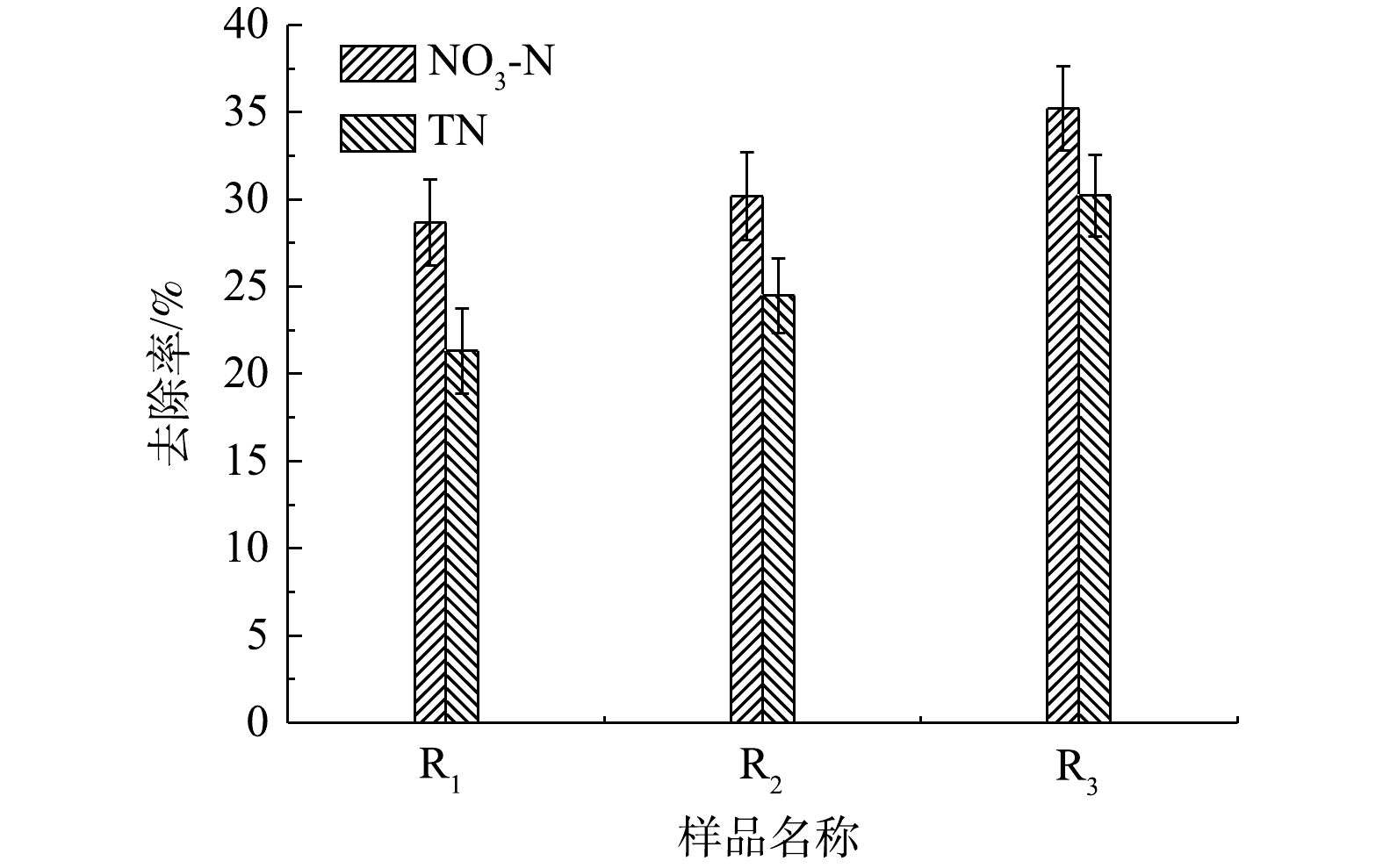


 下载:
下载:
